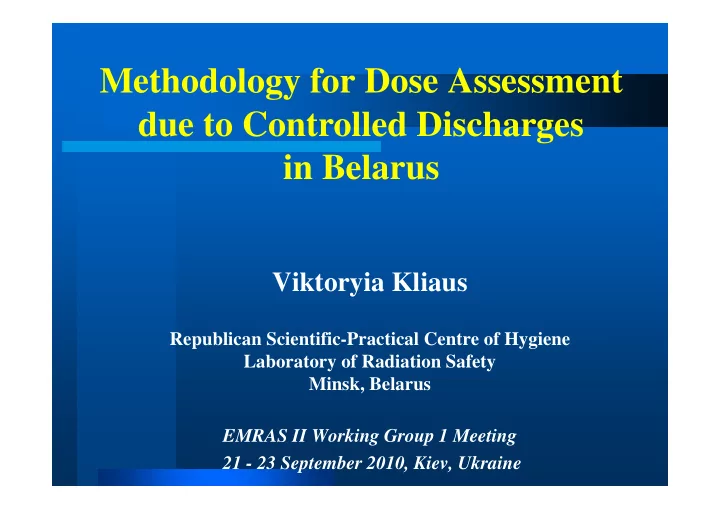

Methodology for Dose Assessment due to Controlled Discharges in Belarus Viktoryia Kliaus Republican Scientific-Practical Centre of Hygiene Laboratory of Radiation Safety Minsk, Belarus EMRAS II Working Group 1 Meeting 21 - 23 September 2010, Kiev, Ukraine
Scenario A - Inputs Radionuclides: Co-60,Cs-137, I-131, Kr-85 Atmospheric release: 10 12 Bq/y Effective release height: 19 m Critical group: − adult − 300 m from the site − 20 % of total time outdoors − local food consumption (cow milk, cow meat, sheep meat, fruit, green and root vegetables) − Inhalation rate 8400 m 3 /y
PC-CREAM 08 ASSESSOR – individual and collective doses from routine releases Activity concentrations from a number of pathways are combined with habit data either from defaults or user defined for the assessment
Supporting Models PLUME – Gaussian plume model: activity concentrations in air, deposition rates and cloud gamma dose rates for specified release rate. FARMLAND – Compartmental model for soil, vegetation and animals: activity concentrations in foods per unit deposition rate. GRANIS – Compartmental model for soil and gamma dose from infinite plane: time integrated ground gamma dose per unit deposition rate over one year. RESUS – Garland model for resuspension: time integrated activity concentration in air per unit deposition rate over one year.
Exposure Pathways Atmospheric Dispersion Inhalation Ground Deposition Resuspension Cloud External Ground Food External consumption
Typical applications PC CREAM uses effective dose – as defined in ICRP Publication 60 – dose coefficients from ICRP Publication 72 – committed to age 70 – 3 age groups 1 year old infants 10 year old children Adults
External Dose Dose rate, Sv/y Co-60 Cs-137 I-131 Kr-85 1.16E-07 5.95E-09 1.89E-08 _ Air immersion (Cloudshine) 1.57E-04 9.40E-05 4.01E-06 _ Groundshine 3.78E-08 1.18E-10 6.21E-09 4.37E-10 Direct radiation
Internal Dose Dose rate, Sv/y Co-60 Cs-137 I-131 Kr-85 8.35E-07 4.83E-06 1.29E-05 _ Green vegetables 2.02E-07 4.54E-05 3.80E-05 _ Root vegetables 1.65E-07 5.83E-06 6.12E-06 _ Fruits 1.72E-07 7.68E-05 8.96E-05 _ Cow milk 1.90E-08 5.28E-05 3.95E-06 _ Cow meat (beef) 1.30E-09 4.27E-06 2.26E-07 _ Sheep meat 4.02E-06 1.93E-06 3.09E-06 1.90E-10 Inhalation
Total Dose Radionuclide Dose rate, Sv/y 1.62E-04 Co-60 2.86E-04 Cs-137 1.58E-04 I-131 2.47E-10 Kr-85 7.14E-04 Total
Total Dose (2) 3.00E-04 2.50E-04 Dose rate, Bq/y 2.00E-04 1.50E-04 1.00E-04 5.00E-05 0.00E+00 Co-60 Cs-137 I-131 Kr-85 Total dose for the member of the critical group – 7.14E-04
Contribution to Dose 1.60E-04 Cloudshine 1.40E-04 Groundshine Direct radiation 1.20E-04 Inhalation 1.00E-04 Dose rate, Sv/y Green vegetables 8.00E-05 Root vegetables 6.00E-05 Fruits 4.00E-05 Cow milk Cow meat 2.00E-05 Sheep meat 0.00E+00 Co-60 Cs-137 I-131 Kr-85
Critical Radionuclide and Pathway Pathway breakdown Radionuclide breakdown
The Concept of ‘Critical Group’ The ‘critical group’ concept is used for the purpose of protection of the public in Belarus to characterize an individual who is representative of the most highly exposed individuals in the population It is important to consider some aspects : The location and age distribution of the potentially exposed group Dietary habits Special occupational habits The type of dwelling Behavior factor
The Concept of the ‘Representative Person’ For the purpose of protection of the public, it is necessary to characterize an individual who is representative of the most highly exposed individuals in the population. This individual is de fi ned as the ‘representative person’. The representative person may be hypothetical. Nevertheless, it is important that the habits used to characterize the representative person are typical habits of a small number of individuals representative of those most highly exposed and not the extreme habits of a single member of population.
The Concept of the ‘Representative Person’ The Commission now recommends the use of the ‘representative person’ for the purpose of radiological protection of the public instead of the earlier critical group concept (ICRP, 2006b) So Today Belarus revises National Standards according to the new ICRP concept of the ‘representative person’ Permissible Levels of Standards of Main Hygienic Concentration of Radiation Safety- Rules and Norms- Radionuclides in Food 2000 2002 Products
NPP in Belarus Type: NPP-2006 Reactor: WWR (PWR)- 1200; Planned construction time: 54 month Lifetime at 90% capacity factor : expected 50 years General layout of Belarusian NPP The WWR 1200 will was developed for 2 power units produce: (2016 and 2018 years) 1200 MW(e) electric power 3200 MW(th) heat power
NPP in Belarus (2) City Distance, km Ostrovets Lithuanian boarder 20 area Oshmyany (Belarus) 25 Vitebsk Smorgon (Belarus) 35 Vilnius (Lithuania) 50 Lida (Belarus) 100 Mogilev Minsk Daugavpils 150 Grodno (Lithuania) Grodno (Belarus) 175 Suwalki (Poland) 200 Riga (Latvia) 300 Gomel Warsaw (Poland) 400 Brest Lutsk (Ukraine) 450 Rivne (Ukraine) Kiev (Ukraine) 550 Vienna (Austria) 1000 Future location of the NPP
Population distribution around NPP N S 30 km from the site 5 km from the site Total population – 35 682 persons Total population - 765 persons
Critical Group Real group Rural population Adults (>17 years) 50% of total time outdoors: − foresters − shepherds − retired people Local produced food consumers
Consumption of Food Product Intake, kg/y (l/y)* Cow milk 62.99 Cow meat 33.82 Sheep meat 0.35 Green vegetables 15.28 Root vegetables 82.03 Fruit 29.82 * Ministry of Statistics and Analysis of the Republic of Belarus Data Book, 2009
Inhalation Breathing rate, m 3 /h Age, years <1 2.86 1-2 5.17 2-7 8.72 7-12 14.2 12-17 20.11 >17 22.22
Thank you!
Recommend
More recommend